Hundreds of thousands of victims. Ruthless extermination of political opponents. Public executions. Concentration camps. All this must be written into the account of General Francisco Franco. And although today many do not want to remember the crimes of the Spanish dictator, it is high time to recall them.
The Spanish Civil War (1936-1939) - like any ideologically motivated civil war - was marked by extreme cruelty. Both the warring sides, the Republicans and the national forces of General Francisco Franco, committed crimes, and their brutality went well beyond the "normal" practices of warfare. For some time, however, we have been dealing with whitewashing the national side and blaming the Republicans for all the atrocities committed at that time. Meanwhile, Caudillo and his men really have a lot on their conscience.
Shooting, bombing, massacres
The Frankists, who were captured during the fights, were shot. Private prisoners of war were also killed, and even those soldiers who remained neutral and did not take any side of the conflict. It was the first time that civilian cities were bombed on such a scale. The German and Italian air forces supporting Franco destroyed Guernica, killing about 120 people, Durango (250 killed) and Jaen (159 casualties). Raids were also carried out on Malaga, Almeria, Valencia and Barcelona.
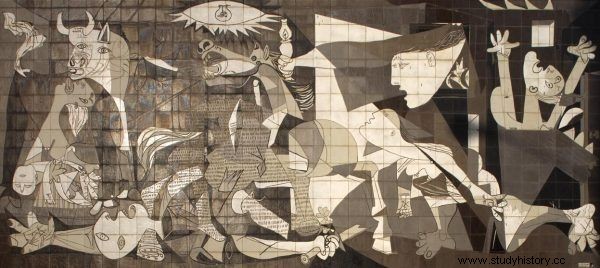
The raid on Guernica inspired Pablo Picasso to create one of the most important paintings of the 20th century. The picture shows a mural depicting the work of a Spanish master (photo:Papamanila; license CC BY-SA 3.0).
The so-called Badajoz massacre gained publicity. On August 14, 1936, the troops of the Spanish Foreign Legion, led by General Juan Yagüe, captured the city located in the western part of the country. After capturing it, they started a massacre of defenders, during which from 2,000 to 4,000 people were shot.
Death did not spare those who managed to escape to Portugal. The authorities there, supporting General Franco's rebellion, sent them back to their abandoned homeland ... Nationalists in the entire province of Badajoz killed over 6,000 to 12,000 people. When Toledo fell into their hands, 200 wounded policemen lying in the hospital were murdered with grenades and bayonets.
Exterminate a third of the male population
In turn, in the occupied territories, rebel forces deliberately introduced a bloody terror, which consisted of arrests, beatings, torture and mass executions. The purpose of the repression was, on the one hand, to physically eliminate the supporters of the Republic, and on the other hand, to deter the population from supporting the legitimate government.
As one of General Franco's adjutants, Capt. Gonzago de Aguilera, had to exterminate a third of the male population and rid the country of the proletariat . And so it was done. After entering the captured city or village, the army immediately killed representatives of the central government - civil governors, as well as mayors, union leaders, officials and militiamen. It also happened that people who simply supported the government or voted for the People's Front in the 1936 elections were murdered.
Liberals, typists and freemasons
As the army moved on, members of the Phalanx and Carlists joined the action. Now they were organizing a purge by catching up and eliminating political and social activists from the left. The suspects were intellectuals, doctors, teachers, journalists, writers and generally all considered liberals or leftists. This is how, for example, the poet Federico Garcia Lorca died, shot in August 1936 near Granada.
His killer, a Falanga landowner, Juan Luis Trescastro, was said to have said: We killed Federico Garcia Lorca. Since he was a fagot, I shot him twice in the ass . It was so absurd that typists working in revolutionary committees were shot. In turn, the well-known British historian Antony Beevor states in his book "The Fight for Spain 1936-1939" that a hundred people accused of belonging to the freemasonry were shot in Huesca, while the local lodge did not have even a dozen members ...
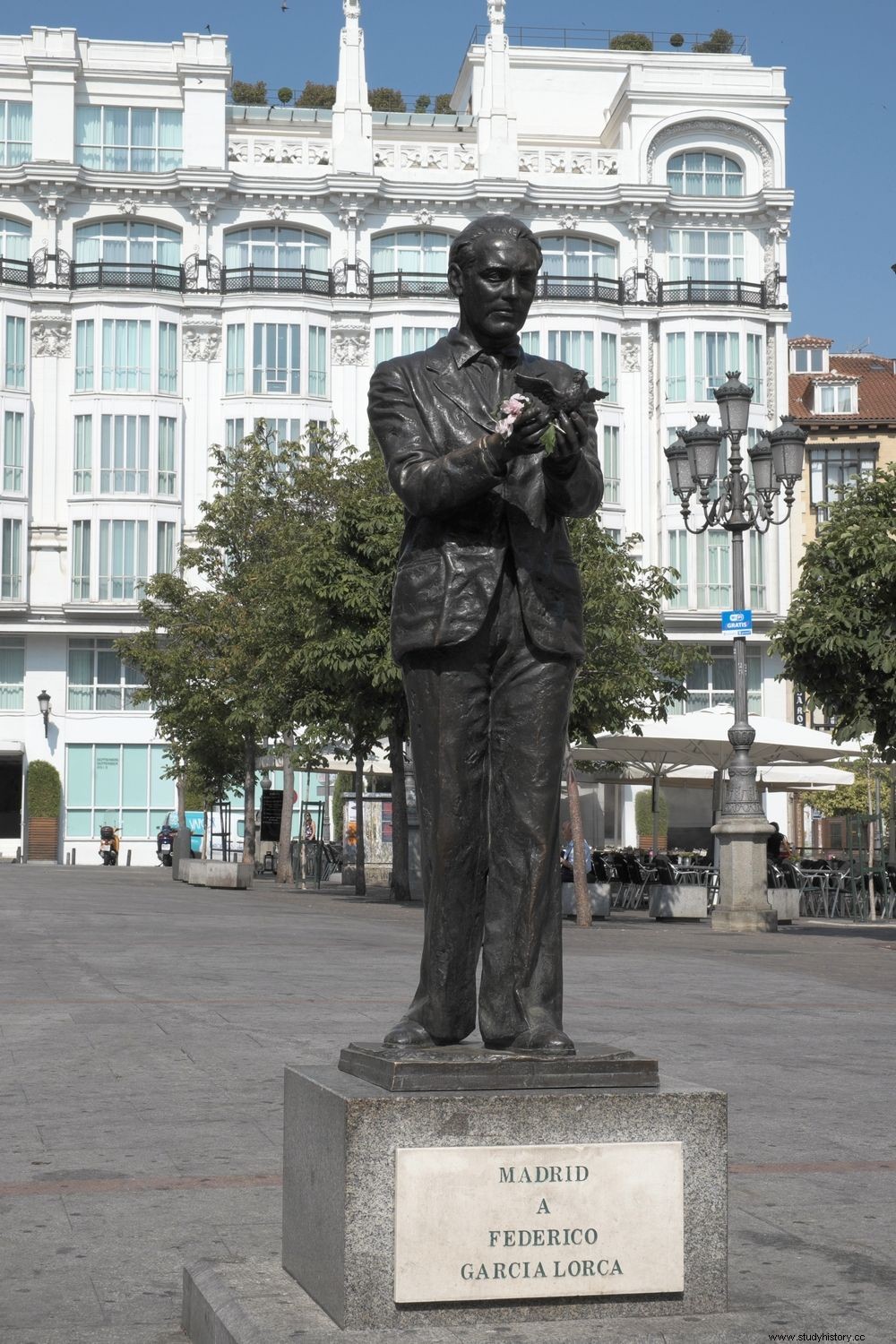
Federico García Lorca was among the victims of General Franco's people. The poet died because of his sexual orientation. The illustration shows the Madrid statue of Lorcia (photo:GFreihalter; license CC BY-SA 3.0).
From Execution to Procession
The shootings were carried out in cemeteries, in prisons, in forests near the city, in secluded places or, on the contrary, in public places. Most often, the detainees were taken outside the city at night, placed in the light of car headlights over a dug hole or over a cliff and shot.
In Granada, about 2,000 people died in the prison there. In Seville and Huelva, special trucks called "meat carts" were used to transport the bodies to the cemetery. In the capital of Castile, Burgos, people were driven out every night to be shot on the side of the highway. In Teruel, the murdered were thrown into shafts over 80 meters deep. It also happened that the bodies of the dead were left for public view, which was to be a warning to others.
The aforementioned Antony Beevor cites a case from Pamplona, where on August 15, during a procession in honor of Our Lady, phalangists and requetés (members of the ultra-right monarchist Carlist militia) arrested several dozen suspects. They were taken outside the city and shot, and the perpetrators could still return to Pamplona and join the procession just entering the cathedral.
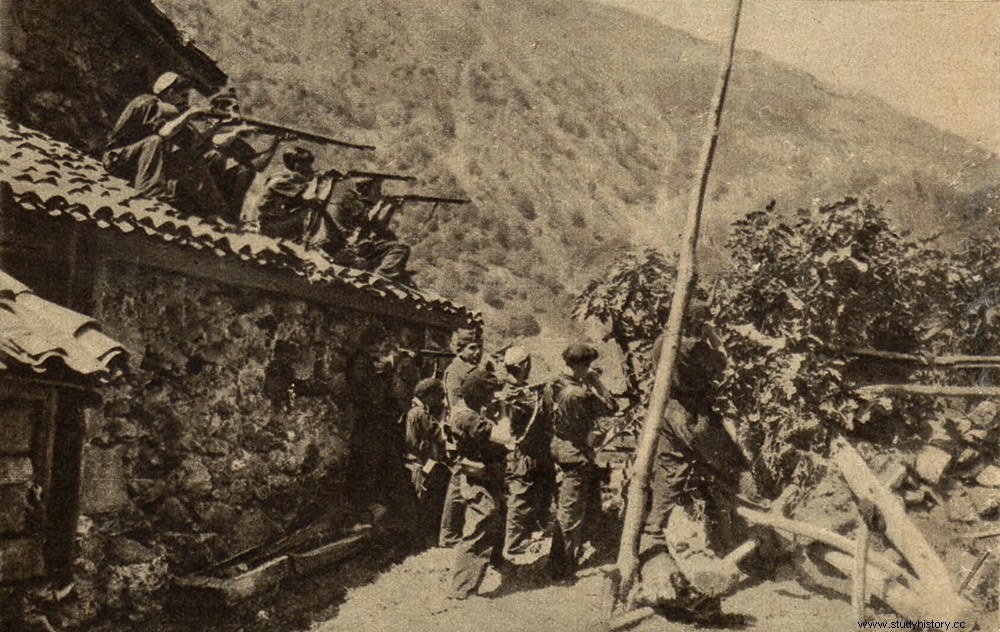
General Franco's supporters had no mercy for their opponents (source:public domain).
Another story about requetés is that they forced captured republicans to lie down on a cross and then cut off their limbs with the cry "Long live Christ the King" . In Huelva, in southwestern Spain, the phalanxes killed more than 2,000. people, including a civilian governor, commanders of the Guardia Civil, and policemen loyal to the government. 2.5 thousand residents fled the city.
Here are the Moroccans coming
Another type of repression was sexual violence. It was especially notorious for soldiers from Moroccan troops. Frankist general Queipo de Llano scared the listeners (and especially the listeners) of Radio Seville with stories about the sexual possibilities of these troops, to whom he promised women from the captured Madrid to encourage them. It didn't end with scaring.
Near Gibraltar, the wife of a republicans was raped by a Moroccan firing squad, who then shot her. American press correspondent John Whitaker witnessed the devotion of two young girls to Moroccan soldiers. The commander calmly said that they would not survive more than four hours…
Spectacles of death
Many executions of the supporters of the republic were carried out in public. In the city of Valladolid, those arrested were held in tram cars, and a dozen or so were taken out and shot every day in front of the crowd.
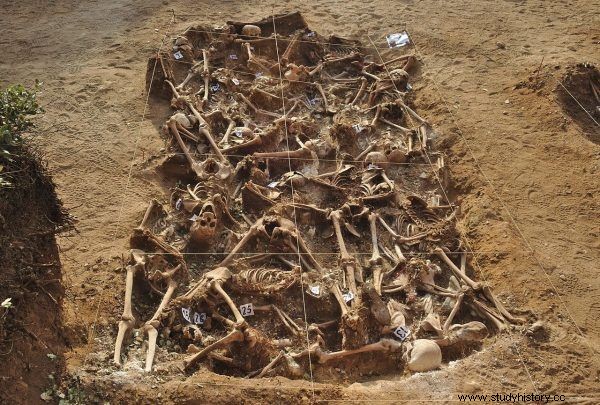
One of several mass graves discovered by archaeologists for the victims of General Franco's forces in Estépar near Burgos (photo by Mario Modesto Mata; license CC BY-SA 4.0).
This is what the apothecary Jesús Álvarez quoted by Beevor wrote about it:
The crowd that came to watch this show was not entirely illiterate. They were people with a certain position, sons of excellent families, educated people who considered themselves religious (...) they came to watch these executions regularly, so there were stalls nearby selling coffee and pancakes so that they could eat and drink while watching .
After some time, the city's civil governor's office issued a statement that too large crowds were gathering in the execution sites. It also called on citizens not to not come to see such things, let alone bring their wives and children …
Following the German pattern
In 1936, the Frankists established the first concentration camp at El Hecho Castle in Ceuta. The first but not the only one. Republicans, oppositionists, homosexuals and common criminals were sent to Spanish camps (often without a court sentence). Established in 1937, the Miranda de Ebro camp was based on the model used in the Third Reich, and its organization was supported by the SS and Gestapo.
During World War II, Poles were sent there to try to get from France to Gibraltar or Portugal. Among them was the later known Krakow psychiatrist prof. Antoni Kępiński, who struggled with the camp trauma for the rest of his life. Heinrich Himmler himself visited the camp. And what is significant in Spain, the legacy of the Third Reich lasted much longer than Hitler's state. The camps were not closed until 1947!
Clearing Spain
Repressions against republicans and leftists continued after the end of the war. Until 1952, 50,000 people were sentenced to death, of which about half were carried out. In the words of one of the Spanish bishops, a scalpel was needed to drain the pus from the guts of Spain .
As noted by the Polish historian Paweł Machcewicz, for comparison, in the Stalinist era (from 1944 to 1956), several thousand death sentences were carried out in Poland (probably 3-4 thousand). The total number of victims (killings and executions) of the Frankist regime is estimated by Antony Beevor at 200,000.
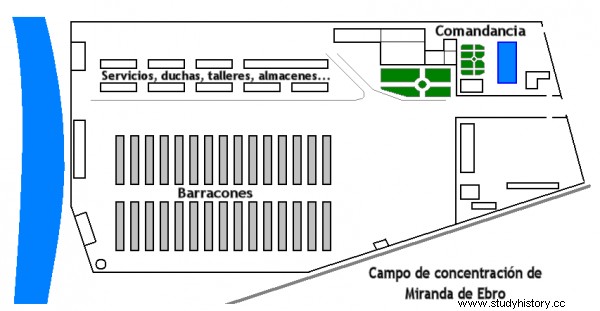
Franco, using Nazi patterns, locked his opponents in concentration camps. The illustration shows the plan of the Miranda de Ebro camp (author:Mr. Benq; lic. Public domain).
There was a story in Spain that Franco would readily repeat the words spoken on his deathbed by the 19th-century general Narvaez. When asked if he had forgiven his enemies, he replied: I have no enemies. I shot them all. Thousands of Spaniards do not know the burial place of their relatives and relatives murdered during the Civil War.
A country without a constitution
The Frankist Political Accountability Act of 1939 allowed a prison or concentration camp for those who collaborated with the legitimate Republican government. Political prisoners were sent to concentration camps for many years, and homosexuals were sent to psychiatric hospitals. Torture was used in prisons.
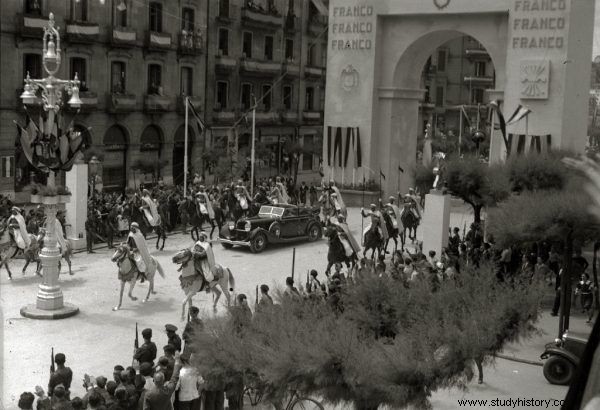
After taking full power in the country, General Franco had no intention of forgiving his opponents. He ruled with a hard hand until his death. Pictured:Franco's entry into Donostia (San Sebastián) in 1939 (photo:Fondo Marín. Pascual Marín. Kutxa Fototeka; license CC BY-SA 4.0).
It was possible to get there after a group trial lasting several minutes, during which 50-60 people were tried at once. The children of Republican activists were massively taken from their parents, and transferred to right-wing families or to orphanages run by the Church, where they were brought up according to Frankist ideology.
Such a fate could befall from 30,000 to 40,000 children. Political opposition was forbidden and the media was severely censored. Until 1967, Spain had no constitution. The dictatorship - though milder over the years - lasted until the death of General Franco in 1975.
***
This article was inspired by Jessie Burton's novel Muza (Wydawnictwo Literackie 2016). It is an original story about artistic freedom, finding your own form of expression and searching for creative redemption. On its pages you will find eye-catching characters, skilfully drawn narration and the atmosphere of two eras - Spain at the beginning of the Civil War and London in the 1960s.
